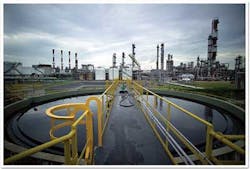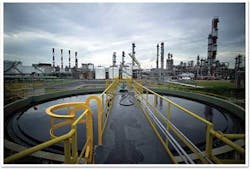Polymer Performance: Design Considerations for Liquid Polymer Feed and Control Systems
By Dan Glitto
Operators across a broad range of industries routinely use liquid polymers to enhance the performance of various liquid-solid separation technologies such as clarifiers, belt presses, DAF units, centrifuges, filter presses, etc. The ability to optimize the performance of this equipment with proper solids flocculation and coagulation is directly related to the efficiencies of the equipment used to prepare the polymer solution.
There are several manufacturers of in-line, stand-alone systems marketed for this purpose. Selecting the right one for a particular application can be confusing; however, there are a number of key principles and design parameters to consider in selecting and operating a polymer feed and control system which should help the evaluation.
Remember that the system used to prepare the polymer at the proper concentration must be designed to fully hydrate or "uncoil" the polymer molecule. This hydration is required to expose the active sites along the polymer molecule to the substrate they were intended to treat. Maximum exposure to these charge sites will translate to optimized performance of the polymer.
In order for this to occur, the interface between the dilution water and neat polymer should be designed to apply the right amount of energy at the point where the water is mixed with polymer. If inadequate or improper energy is applied to the polymer/dilution water interface at the "moment of initial wetting," agglomerations will form. These agglomerations are commonly called "fisheyes" or "stringers." As these agglomerations occur, they tend to entrap undissolved polymer at the core of the agglomeration. This is wasteful and diminishes the efficacy of the program and usually results in plugging and increased maintenance.
Once the polymer begins to hydrate (uncoil), it becomes very fragile. Continued exposure to high shearing energy will destroy the long-chain polymer molecules. The hydrodynamic force required to break a carbon-carbon bond (the bonds that hold the monomers together to create the polymer chain) is very slight.
A million polymer molecules can be ruptured by the force of 0.01 N, a force equivalent to 1 gram of free-falling water. This is a significant revelation in the assessment of a system design: If the force of a raindrop can destroy a million carbon-carbon bonds, one can imagine the impact of continuous exposure to high-energy zones. Thus, top performance will be attained by controlled high energy at the moment of initial wetting to begin hydration and prevent agglomerations. The design should then enable the solution to move quickly from the high-energy zone to calmer, lower-energy zones of mixing to avoid the destruction of polymer and the associated drop in performance and economic efficiency.
Some in-line polymer activation systems are designed with an understanding of the rate of hydration phenomena associated with typical liquid polymer flocculants. These systems pump precise amounts of neat polymer into mixing environments where hydration and dilution begin. The time that the polymer solution needs to be exposed to this mixing process is directly related to the ability of the system to prevent agglomerations. The rate of hydration (how fast the polymer solution can be readied for delivery to the point of application) hinges upon the polymer particle size. As particle size increases, the required aging time increases. In fact, there is a direct relationship between aging time and particle size that is well documented: Hydration time increases by the square of the radius of particle size.
The key to minimizing polymer damage and optimizing the polymer program effectiveness is the prevention of agglomerations, which occur in the first milliseconds of initial wetting. This must be performed with a high, hydrodynamic shear energy that disperses the polymer into small particles.
These small particles hydrate much more rapidly than those allowed to form agglomerations. Adequate dispersion energy greatly truncates the time that the polymer solution needs to be mixed. Herein lies the explanation of how a properly- designed and operated polymer feed systems can reduce polymer usage. A proper design prevents agglomerations, promotes rapid full hydration and minimizes the destruction of polymer molecules.
In addition to usage reduction, the proper magnitude and type of energies employed at the moment of initial wetting should improve the polymer performance. Again, by preventing even micro-agglomerations from forming, an efficient design will maximize hydration and the corresponding charge site exposure to the substrate. This capability translates to improved polymer performance in virtually any polymer application.
In addition to the technology of activation principles, a pragmatic assessment of the polymer feed system design is important. Some systems include an on-board touch-button controller that allows the operator to initialize and operate the unit with a simple touchpad/LED interface. Control of neat polymer feed and dilution water should be simple and straightforward. Some smart systems allow the operator to select a dosage and concentration either locally or remotely and let the system produce and feed the solution at the desired rates and concentration.
Further consideration should be directed toward determining the ease of setup and operation. Is it laid out for easy access to critical components? What about parts availability? Other important questions to ask include the following.
Does the system:
- automatically adjust polymer rate based on dilution water flow?
- automatically maintain selectable polymer concentration?
- display a real-time concentration and polymer feed rate?
- provide an on-board touch-button, alphanumeric-LED operating system?
- include remote and local modes of operation?
- provide multiple-stage mixing?
- include automatic selectable-system flushing?
- provide a means for neat polymer calibration?
- provide a digital display of dilution water flow rate?
- include a dual pump option for duty/standby configuration?
- provide an on-board PC pump option?
- provide an on-board calibration assembly?
- include standard on-board post dilution?
- provide a low-dilution water-flow alarm?
- provide hydrokinetic, motorless, mixing to eliminate belts, shafts and motors?
- provide open architecture for easy maintenance?
- provide a mix chamber flush port?
- include a neat polymer priming port?
- provide parts readily available?
- include push-button polymer priming?
- provide a digital-annotated alarm indicator?
Summary
Cost-effective performance of a polymer program is tremendously influenced by the activation mechanics described above.
We have seen that the proper amount of controlled dispersion energy at the moment of initial wetting prevents agglomerations. This, in turn, eliminates the need to expose the polymer to extended aging time and the polymer destruction associated with that process. Thus, waste is minimized and overall polymer consumption is reduced.
Further, the prevention of agglomeration promotes the full hydration of the polymer molecules. This, in turn, maximizes charge-site exposure, which ultimately improves polymer performance. We can now understand the basis of the "more for less" phenomenon, as witnessed from properly-designed in-line liquid polymer feed and control systems.
Lastly, a common-sense review of the physical design that includes an examination of the ease of operation and availability of some essential features will help ensure the selection of a system that is right for the application for years to come.WW
About the Author: Dan Glitto is vice president of EquipSolutions (Hanover Park, Ill.). EQS provides a broad offering of standard and custom-engineered water treatment equipment and services supported by a strong field service team.

